Eagle Ridge is not a well known course. Opened in 2004, it's an Art Hills design and part of the Kentucky State Parks Golf Trail. It lies virtually on the West Virginia border, some 30 miles south of I-64. In other words, it takes some effort to find.
For Kentucky golfers though, it has generated quite a buzz. It has more than its fair share of admirers and many who also despise it. I know several people who travel from 2 or more states away to play it annually. I also know a few who consider it awful and will never play it again. It has often been discussed, sometimes been ranked, and generally drawn polarizing opinions.
Here on GCA, Doug Ralston has named it a personal favorite and advocated strongly for players to make the significant trek to see it.
I played it last week. I will profile it a few holes at a time. I hope to hear what GCA'ers think of it by looks of the photos. For my part, I'll be doing my best to remain neutral until all holes have been posted, at which point I'll share my own impressions of it. It plays 6630 from the tips, and slopes to something ridiculous like a 153. I played from one tee up, though with all the elevation change it doesn't make much difference. All yardages listed from the #2 tees.
1st hole: 382 yard par 4
The course begins with a relatively benign dogleg right par 4. Plenty of width off the tee makes it a fairly simple layup to the fat part of the fairway. A more foolish player could pull driver and try to carry the bunkers. I don't have a yardage guide in front of me as I write, but it really doesn't matter. Eagle Ridge features so much elevation change that the yardage guide is largely useless, and it's very difficult to know with any certainty how far away a target will play.

While Eagle Ridge features very severe terrain, the approach at 1 actually makes nice use of some ground contours left atop this mountain it traverses. Approaches can be run on from the right using some mounds, but an imprecise shot risks falling into a hidden hollow near the green.
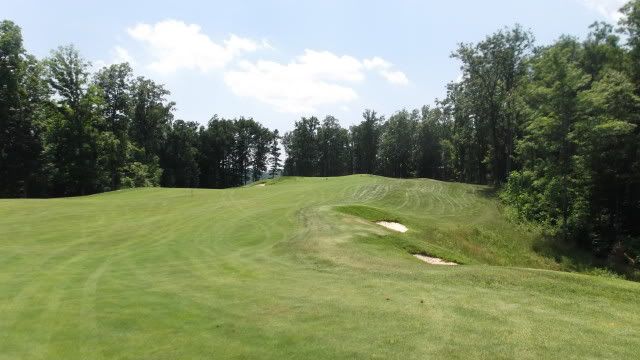
From the hollow, some 4 feet below the green.
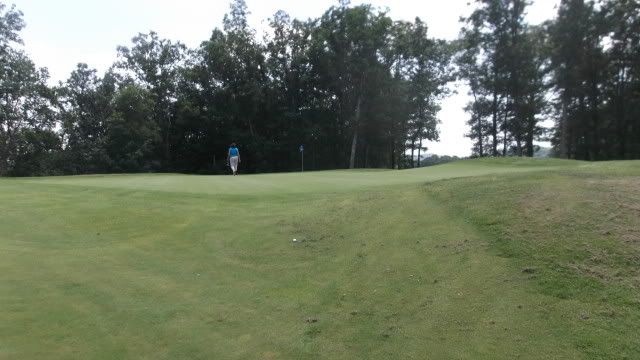
2nd hole: 385 yard par 4
The difficulty with profiling Eagle Ridge is showing the dramatic elevation changes on the property. It's really unlike anything I've ever seen on a golf course. While you can see there's a significant drop from the second tee, the steepness of it doesn't come through at all here. It's probably 150-200 feet down to the fairway. The bunkers on the right should be played left of off the tee, and really take a big blast to come into play.
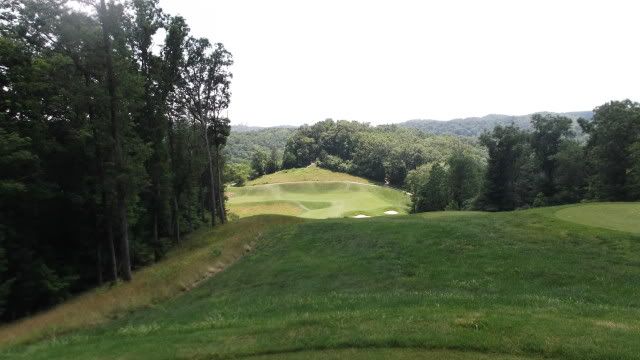
A look from the forward tees shows the fairway, again with ample width in the landing area. That's my mother walking back to the cart (no reasonable human would walk this course) after her typical 190 yard drive. Remember that later.

From the landing area, the approach must traverse a huge ravine. There is no room to miss short or long, and it's extremely hard to hold the layup fairway to the right. It's a do-or-die approach that must be hit high, soft, and precisely, or will end up 20+ feet below the green.

3rd hole: 216 yard par 3
Another severely downhill tee shot. This one probably plays some 100 feet or so downhill. It's a long par 3, and you'll need to hit it perfectly, as there is no chance of finding a ball in that shaggy stuff anywhere on the course. The smart play here might be to aim at the fat tongue of fairway short of the green, but even that isn't much of a bailout. Eagle Ridge is dramatic and requires a lot of heroic shots.
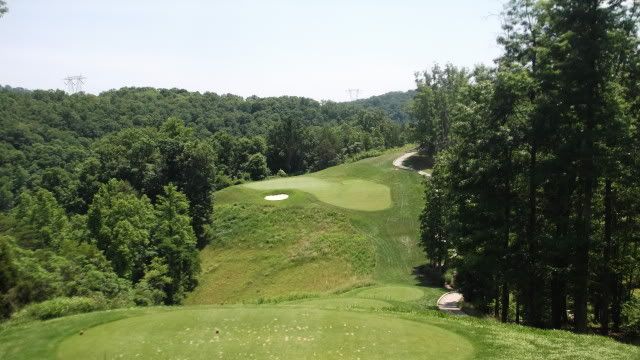
4th hole: 572 yard par 5
The toughest hole on the course begins with another drive over a ravine to a small fairway that slopes fiercely right to left. Eagle Ridge earns that high slope rating by making topshot bunkers look like a high-handicapper's cakewalk.
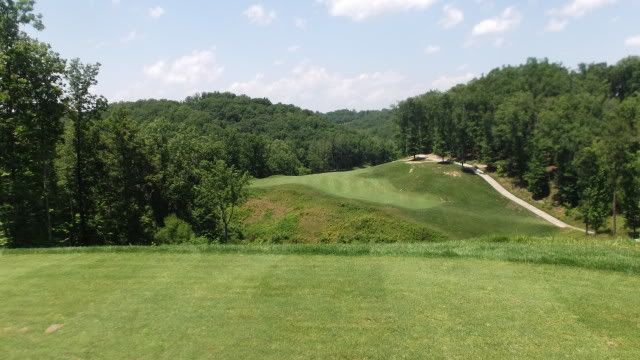
Here's a shot from the end of the first fairway. All of this is blind from the landing area unless you smash a driver to the end of it. You can layup to the tiny fairway benched in the hillside, or hit one hard to the lower fairway. It's impossible to guess the yardage to either, and both present very very small targets. Everything surrounding them is an automatic lost ball.
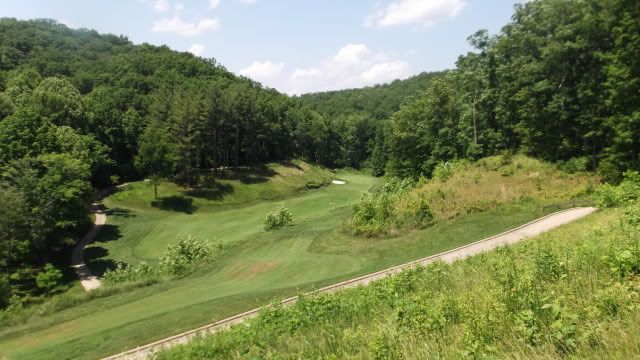
A shot from the lower landing area showing the approach to the green and also the narrowness of this neck of fairway.
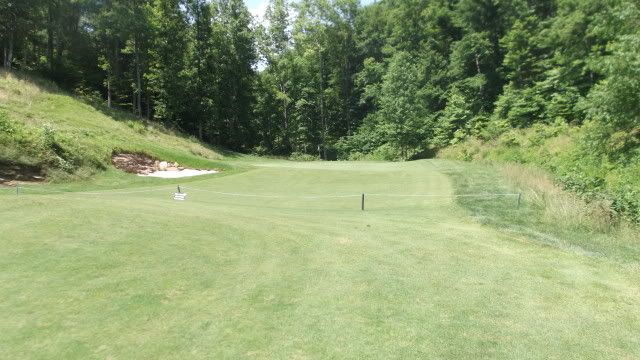
Looking back, showing the narrow lower fairway and the impressive cliff atop which the driving zone sits.

5th hole: 342 yard par 4
Upon reaching the 5th, let out a sigh of relief. You're finally playing a hole over mostly flat terrain. That doesn't mean the need for precision is gone though. You'll need to be sure to favor the left side of the fairway, as anything that leaks right is another automatic lost ball.

The approach. Again, you'll need to fly it all the way there and stop it quickly to avoid the severe dropoffs surrounding the greensite.

6th hole: 412 yard par 4
The 6th features probably the widest fairway on the course, a welcome site after the precision required through the first few holes. Favoring the left side might help a bit with the approach angle, but as you can see here, it's mostly going to need to be another high aerial approach.
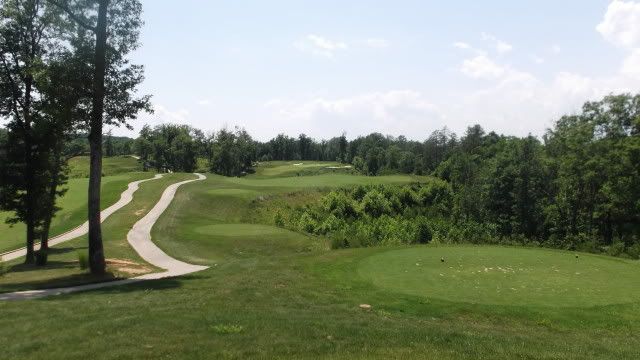
A shot from the landing zone. My mother hit her 190 yard drive here right down the middle again. Unfortunately, the fairway runs out from the forward tees around 130 yards, leaving only this small tongue up the left side if you don't want to lay up. Laying up leaves a 180-ish yard approach at minimum. This seems pretty penal from the forward tee, and my mother's drive down the middle went way too far and turned into another lost ball.
As you can see, the approach is severely uphill and all over a ravine, making run-up shots impossible.

I'd love to hear thoughts so far. More holes to follow.